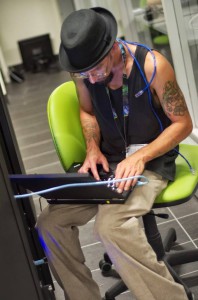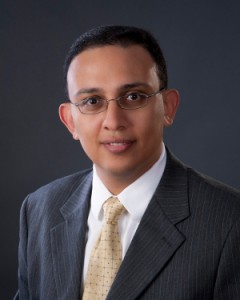2013 Speakers
Schedule
Speakers index
- James Arlen, The Message and The Messenger English talk
- François Lajeunesse-Robert, WebApp ScramblerFrench talk
- Dave Lewis, Robert Masse, Blake Cornell, Olivier Bilodeau, Mathieu, Panel: Responsible disclosure English talk
- Dominique Clément, Les impacts des attaques DDOS sur la sécurité du périmètre réseau French talk
- Sébastien Duquette & Marc-Etienne M.Léveillé, Hide yo Apache, hide yo SSH cause they backdoorin' everybody out there French talk
- François Harvey, Techniques d'évasion antivirale French talk
- Christine Roussel, La GIA … pas toujours parfaite!!!!French Talk
- Robert Masse, DENIAL OF SERVICE AS A SERVICE - ASYMMETRICAL WARFARE AT ITS FINEST English talk
- Benoît H. Dicaire, L'écosystème Apple IOS: toujours invulnérable en 2013? French talk
- Yury S. Chemerkin, Questionable value of MDM from the BYOD's viewpoint English talk
- Olivier Bilodeau, How [not] to suck at CTF Conférence en français
- Blake Cornell, Fuzzing in the 5th Dimension: Why the NSA should have every vulnerability by now English talk
- Georgia Weidman, Bypassing Security Controls with Mobile Devices English talk
- Robert Portvliet, Introduction to Near Field Communications (NFC) English talk
- Jeremiah, Warranty voiding techniques English talk
- Sherif Koussa, Sometimes Your Code Needs an Open Heart Review English talk
- Marc-André Meloche, Divulgation de faille anonyme #FAIL French talk
- Charles F Hamilton, L'appel du shell French talk
- Laurent Desaulniers, Oublié ton mot de passe? Conférence en français
- Noël Lachance, Directeur de l’analyse des technologies, L’importance de la planification dans la prévention des atteintes à la vie privée Conférence en français
- Michael Lahaye, François-Xavier Desmarais, Ne vous inquiétez pas, TLS vous protège ! Conférence en français
Workshops list
TBA
DJs
- Friday November 9th: DJ Fisher, Dupstep, upbeat, uplifting trance, psy-trance, goa, and more!!
- Saturday November 9th: Psychnerd, DJ Set DubStep, Electro House, PsyTrance, Downtempo, Electro Live Act, Downtempo Live Act...and more!
James Arlen, sometimes known as Myrcurial, is a security consultant at Leviathan Security Group usually found in tall buildings wearing a suit, founder of the Think|Haus hackerspace, contributing analyst for Securosis, columnist at Liquidmatrix Security Digest, Infosec geek, hacker, social activist, author, speaker, and parent. He’s been at this security game for more than 19 years and loves blinky lights and shiny things.
The Message and The Messenger
You are a great person - a unique and special snowflake - you have many brilliant ideas. You are completely ineffective at getting those ideas out of your head and to an audience. If you need to stand up in front of a crowd of more than zero and persuasively deliver information - you need to be here. Whether delivering a status report or standing in front of an audience, there are ways to deliver information that will increase the chances that people will retain and act upon it. Join this fast-paced talk during which there will be some instruction, some ugly self-evaluation and path you can follow to get from Idea to Delivery. Stop presenting like crap and failing to get your point across.
François Lajeunesse-Robert, est un consultant en sécurité de l'information se spécialisant en sécurité applicative. C'est en tant que développeur et passionné de mathématiques qu'il a été amené à s'intéresser à la sécurité applicative dans le cadre de sa maîtrise en informatique. Ses travaux de maîtrise ayant été présentés dans le cadre de deux conférences internationales et réutilisés par un organisme gouvernemental fédéral.
Dans le cadre de son travail, il a longtemps réalisé des revues de code de sécurité et des tests de pénétration applicatifs. Il se consacre maintenant davantage à l'intégration de la sécurité dans le cycle de développement des organisations.
Il est aussi impliqué depuis plusieurs années dans la communauté du Hackfest dont, entre autres, en tant que confériencier aux Hackerspaces sur des sujets combinant la sécurité informatique et les mathématiques.
WebApp Scrambler
Les scanners applicatifs fondent leur fonctionnement principalement sur le fait que les applications Web sont prévisibles et qu’il est facile de déterminer si deux comportements sont identiques ou non. Pour arriver à les contrer efficacement, il faut donc parvenir à rendre les applications Web imprévisibles et rendre la différenciation de comportement difficile. Ceci n’est cependant pas une tâche facile. Afin de la simplifiée, les scanners applicatif ont été divisés en deux catégories.
Premièrement, il y a les scanners applicatifs chargés d’effectuer de la reconnaissance sur les applications. Cette catégorie regroupe, entre autres, les outils de « spidering » et les outils de « directory bruteforce ». Deuxièmement, il y a les scanners applicatifs chargés de conduire les attaques sur les applications Web. Cette catégorie regroupe principalement les « fuzzer ». Bien qu’il ait été relativement facile de se prémunir contre la première catégorie de scanners, ce ne fût pas le cas pour la seconde catégorie. Malgré tout, fort des résultats obtenus, un Framework d’offuscation des requêtes/réponses HTTP s’exécutant indépendamment des applications Web a été créé. Ce Framework ainsi que les résultats des tests contre des scanners applicatifs connus seront présentés.
Dave Lewis
Dave has over 15 years industry experience. He has extensive experience in IT operations and management. Currently, Dave is a Senior Security Advocate for Akamai. Dave is the founder of the popular security site Liquidmatrix Security Digest and co-host of the Liquidmatrix podcast. Dave is also has a blog on CSO entitled "Brick of Enlightenment"
Prior to his current role, Dave worked in the finance, healthcare, entertainment, manufacturing and critical infrastructure verticals. He has worked for a defense contractor as a security consultant to clients such as the FBI, US Navy, Social Security Administration, US Postal Service and the US Department of Defense to name a few.
Blacke Cornell
Blake Cornell has been an IT innovator and developer with over a decade of experience within software and security. He has consulted Fortune 500 companies and various law enforcement agencies with hopes of enacting solutions to ease every day issues. His research has included the discovery and vendor resolution of several VoIP zero-day vulnerabilities and several application level fuzzers. One fuzzer in particular, sipArmyKnife is included within the Kali Linux penetration testing distribution. He is currently the Chief Technical Officer of Integris Security LLC
 Coming from the dusty Unix server room world, Olivier evolved professionally in networking, information security and open source software development to finally become malware researcher at ESET Canada. Speaking at Defcon, publishing in (In)secure Mag, teaching infosec to undergrads (ÉTS), driving the NorthSec Hacker Jeopardy and co-organizer of the MontréHack CTF training initiative are among its note-worthy successes. A true devil's advocate at his heart, Olivier likes controversial opinions and creating good debates.
Coming from the dusty Unix server room world, Olivier evolved professionally in networking, information security and open source software development to finally become malware researcher at ESET Canada. Speaking at Defcon, publishing in (In)secure Mag, teaching infosec to undergrads (ÉTS), driving the NorthSec Hacker Jeopardy and co-organizer of the MontréHack CTF training initiative are among its note-worthy successes. A true devil's advocate at his heart, Olivier likes controversial opinions and creating good debates.Robert Masse

Robert Masse is an accomplished visionary, security strategist and business leader with twenty years of experience in security and information technology. Leveraging an energetic leadership style with effective execution skills, he has a strong ability to present complex security and business issues with clarity and credibility that allows him to secure management alignment to obtain company objectives.
An entrepreneur at heart, Robert has enjoyed contributing to the success of several start-ups over the last 15 years, with his most recent company earning him a semi-finalist position for the Ernst & Young Entrepreneur of the year award.
Over his career, Robert has been widely recognized for his ability to give proper executive guidance to mismanaged business initiatives that have spanned across the globe (with a strong focus in Asia).
Panel: Responsible Disclosure
Lets have a discussion about vulnerability disclosure. How should we disclose vulnerabilities? Fully, responsibly or sell them? Is a 7-day window like Google's still responsible? Why hard rules about responsible disclosure don't scale from Web applications to industrial systems or mobile phones regarding fixes deployment? How can researchers make money selling vulnerabilities? Should they or is it extortion? There is a lot to say on this topic including talking about: Google, Facebook's bounty programs, the Zero-Day-Initiative, releasing Proof-of-Concept or not, certain industries' legal constraints, etc. Join us for an interesting debate!
Questions for the panelists are published on a Google Moderator that we will use during the presentation: http://goo.gl/BiU3cH. Due to the breadth of the topic, we encourage you to ask and vote on questions that matters the most to you.
Click here to download the slides
Dominique Clément est Diplômé des HEC en Technologie de l’information, Dominique Clément possède plus de 12 ans d’expérience en informatique. En plus d’avoir occupé plusieurs postes de gestion dans ce domaine, il a eu le privilège de travailler dans des environnements d’envergure où la sécurité du périmètre est critique. Grâce au travail effectué avec Radware, entreprise qui se spécialise en protection contre les attaques DDOS, et son implication avec le « Printemps québécois », M. Clément a développé une expertise unique dans le domaine de l’hacktivisme et de la protection contre les attaques DDOS.
Les impacts des attaques DDOS sur la sécurité du périmètre réseau
Nous vous invitons à cette conférence pour en apprendre davantage sur la montée de l'hacktivisme et les attaques DDOS. Cette nouvelle réalité apporte de grands changements au niveau de la stratégie que les spécialistes en sécurité doivent prendre pour protéger adéquatement le périmètre du réseau. Êtes-vous prêts? Nous vous invitons à venir en apprendre plus sur les techniques d'attaques. La conférence inclus une présentation des plus récentes statistiques concernant les attaques DDOS et les conclusions de l’étude « Radware’s 2012 Global Application and Network Security Report on DDOS »
Click here to download the slides
Sébastien Duquette. Malware Researcher chez ESET.
Je m’intéresse particulièrement à l’utilisation du web pour la distribution de logiciels malveillants. J’aime aussi participer à des CTF avec l’équipe CISSP Groupies et je m’implique dans l’organisation de Montréhack. Ex-membre de Corelan Team, j’ai contribué à la réécriture du script d’aide à l’exploitation mona.py en 2011. Je publie occasionnellement sur mon blog solution-36.blogspot.com et je suis rarement pertinent sur mon compte Twitter @ekse0x.
Marc-Etienne M.Léveillé. Analyste de logiciel malveillant chez ESET depuis 2 ans.
Ancien développeur iOS et OS X, je me spécialise dans les logiciels malveillants qui s'attaquent aux produits fruités et aux oiseaux nordiques. Je participe à l'occasion de façon collégiale aux CTFs avec mes amis CISSP Groupies. Je tweet très peu à @marc_etienne_.
Hide yo Apache, hide yo SSH cause they backdoorin' everybody out there
Afin de contourner les systèmes de sécurité basés sur la réputation, les cybercriminels utilisent fréquemment des serveurs piratés pour distribuer des logiciels malveillants. Les serveurs sont soient utilisés directement pour stocker et distribuer les fichiers malveillant ou alors du code Javascript est ajouté dans les pages du site pour rediriger les visiteurs vers des sites malveillants. Les méthodes utilisées jusqu'ici étaient relativement simples (modification des fichiers existants, ajout de scripts PHP, redirection via des scripts htaccess etc.) et ne demandait qu'un accès limité aux serveurs.Toutefois on observe depuis peu une nouvelle tendance qui consiste à modifier les logiciels installés sur des serveur Linux pour en affecter le comportement et ce à très grande échelle : Plusieurs milliers de serveurs et de sites webs affectés, des centaines de milliers de visiteurs exposés par mois. Nous présenterons des cas concret de modification des serveurs web Apache, nginx et lighttpd (Darkleech, CDorked), de OpenSSH (SSHDoor.A, Ebury) et de serveurs DNS qui ont été découverts au cours de la dernière année. Nous verrons aussi les exigences particulières pour l'analyse de ce type de malware. Nous présenterons le fonctionnement de chacun et le contexte dans lequel ils sont utilisés. Nous porterons une attention particulière aux mécanismes mis en place pour rendre leur détection plus difficile, autant par les logiciels de sécurité que par les administrateurs systèmes. Finalement, nous verrons comment on peut détecter les systèmes
infectés et limiter la propagation de ces malwares.
Clicker ici pour télécharger la présentation
François Harvey est un professionnel en sécurité de l'information, certifié CISSP, CISM et TCSE, spécialisé dans la sécurité de l’information appliquée aux infrastructures sensibles telles que le domaine de la santé et les infrastructures "cloud". Depuis plus de quinze ans, il travaille à la fois sur la défense (gestion d’incidents, architectures de sécurité et solution antivirale) et sur l’attaque (audits applicatifs et tests d’intrusion) au sein de différentes organisations publiques et privées.
Techniques d'évasion antivirale
Pour chaque millier de variantes de virus, certains réussissent à survivre et à prospérer. Comment ont-ils passé à travers les mailles des filets et comment un attaquant pourrait s'en inspirer ?Au cours des dernières années l'arsenal des solutions antivirales a évolué : sandboxing, systèmes de réputation, solutions cloud, analyse comportementale, etc. Mais pour chaque nouvelles défenses, des nouveaux vecteurs d'attaques ont fait leurs apparitions.
L'objectif de cette conférence est de comprendre comment ces mécanismes fonctionnent en détail analyser leurs vulnérabilités, et voir comment un attaquant peut les exploiter à son avantage et les utiliser pour contourner et affaiblir la sécurité d'une organisation.
Robert Masse @Robert_Masse
PHOTO à venir
Clicker ici pour télécharger la présentation
Robert Masse is an accomplished visionary, security strategist and business leader with twenty years of experience in security and information technology. Leveraging an energetic leadership style with effective execution skills, he has a strong ability to present complex security and business issues with clarity and credibility that allows him to secure management alignment to obtain company objectives.
An entrepreneur at heart, Robert has enjoyed contributing to the success of several start-ups over the last 15 years, with his most recent company earning him a semi-finalist position for the Ernst & Young Entrepreneur of the year award.
Over his career, Robert has been widely recognized for his ability to give proper executive guidance to mismanaged business initiatives that have spanned across the globe (with a strong focus in Asia).
Considered a mentor by many employees he has managed and worked with over the years, he provides leadership to his team by promoting and mobilizing professional accountability, coaching and team development.
DENIAL OF SERVICE AS A SERVICE - ASYMMETRICAL WARFARE AT ITS FINEST
Imagine being DDOS'd repeatedly with up to 10Gbps of traffic on a daily basis. Your logs are useless (when your systems are even able to collect data). How do you stop the attacks? Crippling Distributed Denial of Service “As a Service” or DDoSaaS (tm) attacks can be done with $200 lifetime memberships against the largest organizations around - and almost impossible to stop. Asymmetrical warfare at its finest.
The presentation will focus on an investigation that was done in 2013 regarding a large DDOS attack against a regional ISP in Quebec, Canada. The DDOS attack affected tens of thousand of citizens including municipal 911 services (don't ask) to chicken farmers.
We'll talk about the investigative techniques (including social engineering) that were used to track down the suspect and the eventual arrest.
Madame Christine ROUSSEL compte près de trente (30) années d'expérience en informatique et plus de vingt-cinq (25) années plus spécifiquement dans le domaine de la sécurité pendant lesquelles elle a poursuivi l’amélioration de ses connaissances et l’acquisition de compétences par diverses interventions de niveau opérationnel, tactique et stratégique.
Elle réalise depuis plusieurs années des mandats et interventions dans le secteur de la sécurité informatique à titre de spécialiste en gestion de l’identité et des accès et à titre de spécialiste en sécurité sur plate-forme centrale. Elle a réalisé divers mandats dans ces créneaux d’intervention à titre d’analyse spécialiste en sécurité et d’architecte intégrateur en sécurité. Sa collaboration au sein de plusieurs projets a permis d'élaborer et d'implanter des solutions efficaces en matière de sécurité et ce, en cours d’élaboration de solutions d’architecture et de développement de solutions d’affaires. Elle a réalisé le développement de programmes de gestion automatisés de répertoires de sécurité en respect des lignes directrices de diverses entreprises. Elle a de plus développé des processus et méthodes de réorganisation administrative visant l’application des changements de la structure aux différents répertoires de sécurité et de révision des droits d’accès des utilisateurs.En 1997, elle a obtenu diverses certifications sur les produits de sécurité CA-ACF2, CA-LDAP Server et CA-Top Secret. Elle agit également à titre d’instructeur auprès du fournisseur Computer Associates pour les produits « eTrust CA-ACF2 », « eTrust CA-Top Secret », « eTrust Cleanup » et « eTrust Security LDAP Server and LDS for Z/OS and OS/390 ».
La GIA ... pas toujours parfaite!!!!
La conférence permettra de faire la découverte de diverses facettes de la GIA pour lesquelles plusieurs défaillances peuvent être détectées et mettre à risque la sécurité des infrastructures technologiques: Aspects techniques, organisationnels, humains...et plus encore!!! Et ce sous le couvert de l'humour et de l'intérêt pour une meilleure gestion de l'identité et des accès!!!
Benoît H Dicaire est un expert indépendant chez Dicaire Stratégies. Il accompagne les organisations confrontées à des décisions stratégiques difficiles.
Benoît est un expert en sécurité informationnelle et un conférencier chevronné en français et en anglais. À titre de conseiller en gestion depuis plus de 25 ans, il a dirigé plus de 175 mandats de planification stratégique, d'élaboration de cadre de gouvernance et d'architecture TI pour le compte de 40 organisations.
L'écosystème Apple iOS7: Évaluation de sécurité
Cette session couvrira les enjeux de sécurité du système d'exploitation iOS7. La majorité des iPod Touch, iPhone et iPad ont été mis à jour dans les trente jours suivant la disponibilité du système d'exploitation. Cette version comporte des changements importants qui devront être évalués par les organisations et les spécialistes en sécurité.
Click here to download the slides
Yury Chemerkin started as a reverser and security developer and continued to gain experience on malware and mobile security. In the last four years he has been researching Mobile and Cloud solutions (and IAM solutions in general) for exploitation based on misunderstood security principles or developing as a distributed spyware infrastructure. Now he is a broad security researcher and takes part in developing live monitoring and forensics solutions. Also, he regularly contributes with Groteck Business Media, Hakin9 and PenTest magazines as a non-staff writer.
Questionable value of MDM from the BYOD's viewpoint
Mobile device collects an amount of sensitive data should be protected and controlled. Each OS provides extensive APIs that are controlled by a permission system as part of OS. This proposal examines a security model of mobile platforms, their features capabilities to face attacks as native security features enhanced by MDM to bring certain level of trust and transparency. Also, it covers a mobile security in order to compliance standards and guidelines with analysis of gaps that makes an audit checks easy passed with weak metrics. That's a way to taking away from vendor-lock impact, combining different visions on security, analysis of requirements for missing but useful contermeasures on security.
p.s. Some practical cases are aimed to show a real difference between device & MDM security features and possible attacks as well as how far it is in alignment to compliance
Clicker ici pour télécharger la présentation
Fort de 7 ans d'expérience à perdre (et parfois gagner) des "Hacking Games" (CTFs), Olivier a participé à une grande variété de ce genre de compétitions. Les CTFs du style Cyberwar, red vs blue, Jeopardy-board, javascript-RPG et personne-comprend-ce-qui-se-passe, que ce soit offline ou online, n'ont plus de secrets pour lui. Il pense, naïvement, qu'après tout ce temps il a quelque chose a apprendre aux autres. C'est ce qu'il s'apprête a faire. Sinon, dans ses temps libres Olivier travaille chez ESET Canada comme chercheur en logiciels malveillants.
How [not] to suck at CTF
Les "Hacking Games" mieux connus sous le terme CTF (Capture-The-Flag) sont des compétitions où les participants doivent résoudre des problèmes axés sur la sécurité informatique. Les défis rencontrés sont diversifiés allant de l'exploitation (Web, système), la cryptographie, le "reverse-engineering", la "forensic", la réseautique, la stéganographie passant par la reconnaissance, les problèmes algorithmiques, l'administration de systèmes jusqu'au crackage de mots de passe, lock-picking et j'en passe.
Cette présentation départira les faits des mythes de ce genre de compétition, expliquera pourquoi vous devriez participer, divulguera de savoureuses anecdotes de CTFs et établira un ensemble de règles solides pour être certain de perdre tout CTF. Ce faisant, nous nous amuserons et, qui sait, peut-être apprendrons nous a gagner des CTFs...
Blake Cornell has been an IT innovator and developer with over a decade of experience within software and security. He has consulted Fortune 500 companies and various law enforcement agencies with hopes of enacting solutions to ease every day issues. His research has included the discovery and vendor resolution of several VoIP zero-day vulnerabilities and several application level fuzzers. One fuzzer in particular, sipArmyKnife is included within the Kali Linux penetration testing distribution. He is currently the Chief Technical Officer of Integris Security LLC
Mr. Cornell had also presented a topic at an FBI cyber security conference detailing the threats of domestic terrorist cell's using Unmanned Aerial Improvised Explosive Devices (UAIED) within the US mainland. Thirteen months later Rezwan Ferdaus was arrested, charged and eventually sentenced to a 17 year prison sentence for attempting to execute what Mr. Cornell had outlined during his presentation. Cornell also has created the technology behind Clerk 123 LLC. These technologies included remotely controlled full disk encryption appliance platform, intrusion detection and prevention, three-factor authentication solutions, OSINT Acitve Denial System (internal use blacklist) and more. In 2003, Mr. Cornell designed, wrote and implemented a semi-passive network tracking technology which revealed the identify of the IT administrator hosting a majority Islamic Terrorism websites at that time.
He has presented software and security topics at at Briarcliffe College (Bethpage, NY), Astricon 2007/2010, The Last Hope (New York, NY), ICCS 2009/2010/2012 (New York, NY), HIMSS Virtual Conference, regional OWASP events, FRHack, LIPHP and Fordham University.
His work has been mentioned or quoted from organizations such as CNet News, Communications News, Security Focus, Fierce VoIP, United States NIST NVD, Security Vulns, Cabling Installation & Maintenance Magazine, milw0rm, Packet Storm, CBS News, Security Reason, Exotic Liability Podcast, SecLists, HITBSecNews, PC Magazine, Long Island Business News and Newsday.
Fuzzing in the 5th Dimension: Why the NSA should have every vulnerability by now
Quantum computers, at present, are at their infancy. They are computational machines that can simultaneously compute the same function with different values within a dataset. This holds many
implications. Specifically, for me, quantum computers mean a single thing, entropy, and a whole lot of it! Loops begin to look like functions and classical software can become 100% bug free. “[R]esearchers have developed an algorithm that allows [them] to tell whether a piece of software code is bug-free — something that, they note, is impossible with classical computers”. For software to be bug free the software would also have to be vulnerability free. That is unless your intention is to exploit software bugs and never fix them.
High budgeted intelligence organizations, such as the NSA, will not help fix vulnerabilities, only find as many as possible. The intention is to use these vulnerabilities for offensive operations and fixing them it counter-intuitive to that goal. I will make the case for the top echelon of security researchers and organizations to be able to utilize a technique I'm calling: “Quantum Viewed Source Code Unit Testing” or Fuzzing in the 5th dimension.
We'll overview quantum computers role in the end of traditional vulnerabilities, the future of new ones, quantum's implication on classical cryptographic algorithms, what cryptography may resemble in the future and why access to a “quantum computing time-share” would benefit security researchers.
Georgia Weidman is an experienced penetration tester, security researcher, and trainer. She holds a Master of Science degree in computer science, secure software engineering, and information security as well as holding Certified Ethical Hacker (CEH), Certified Information Systems Security Professional (CISSP), NIST 4011, and Offensive Security Certified Professional (OSCP) certifications. Her groundbreaking work in the field of smartphone exploitation has been featured in print and on television including MIT Technology Review, Ars Technica, PC World, Fox News and Global TV Canada. She has presented her research at conferences around the world including Shmoocon, Blackhat, Security Zone, and Bsides. Georgia has delivered highly technical security training at conferences, hacker spaces, and schools to excellent reviews. Building on her experience working in both the public and private sectors, Georgia founded Bulb Security LLC (http://www.bulbsecurity.com), a security consulting firm specializing in security assessments/penetration testing, security training, and research/development. She was awarded a DARPA Cyber Fast Track grant to build the Smartphone Pentest Framework(SPF).
Bypassing Security Controls with Mobile Devices
"We've got Mobile Device Management, BYOD is not a risk for us!" "Our proxy filters all outbound traffic, no one is getting a shell out ever!" Companies are putting a lot of faith in these security mechanisms to stop the threats of mobile devices. In this talk we put those big claims to the test and look at ways to bypass security restrictions on and using mobile devices. For example, we will see if that MDM that claims it can detect rooting/jailbreaking has ever heard of polymorphic code. And that proxy that stops all outbound traffic unless its in the Internet Explorer process authenticated against the domain? Why not just send your shell back to an exploited mobile device in the environment and have it pass the shell out via SMS? Code examples of all the techniques used will be demoed live and released as additions to the author's Smartphone Pentest Framework.
Click here to download the slides
Robert Portvliet is a senior consultant and the network security service line lead for Foundstone. He is also the primary instructor and course steward for Foundstone’s Ultimate Hacking: Wireless and Ultimate Hacking: Expert classes. Robert has presented wireless hacking classes at Blackhat USA 2011, 2012 and 2013, as well as at NYU Poly. He has also given talks on wireless research at Defcon 20 and Phreaknic 16. Robert lives with his wife and a menagerie of cats in New Jersey, and enjoys mountain biking, motorcycling and music in his spare time.
Introduction to Near Field Communications (NFC)
NFC (Near Field Communication) is a set of standards for close proximity communications between two devices or a device and a tag over 13.56MHz, which is quickly gaining in popularity on mobile devices. This one hour talk will begin with the basics of NFC, then cover the protocols and standards involved (LLCP, SNEP, NPP, NDEF, etc.), various modes of operations, and tag types. We will discuss the best hardware to use in order to interact with NFC capable devices and tags, then move on to vulnerabilities discovered in NFC, and NFC capable devices, as well as attacks which have been implemented against those vulnerabilities.
Click here to download the slides
Called to solve complex security issues, Jeremiah aka “magik” is an information security adept possessing exceptional ability to understand the « hacker’s » mind and its desire to defeat security obstacles.
At a young age Jeremiah was being recruited by leading technology companies in the US such as ISS and NASA JPL. He excelled at NASA’s Jet Propulsion Lab (JPL) in building a Tiger Team and successfully performing intrusion and vulnerability assessments. The respected author of numerous articles, books and white papers, Jeremiah is currently an acting Professor at Sheridan Institute of Technology and Advanced Learning where his focus is advanced intrusion prevention systems, malicious code design & defence and ethical hacking. His career has been highlighted throughout the years as an Information Security Consultant, currently residing at Access2Networks, a Toronto based business specializing in IT security.
Their principal consultant, Jeremiah is responsible for providing leadership and focus within the Penetration testing, assessment and incident response teams. Jeremiah lives in the Greater Toronto Area with his three wonderful children and their dog “Teensy”.
Warranty voiding techniques
"Hardware Hacking" is a phrase referring to the modification, cannibalization or combination of new and/or old technologies to create something different, in order to solve a problem, make something more affordable/awesome, testing out an idea, experimentation/education or just because you can.
We all live in a cut and paste world, we have the ability to rearrange our digital lives with just a few clicks of the mouse. Wouldn't it be cool if electronics could be the same way, after all who does not want a hacked keyboard that can bypass hardware key-loggers or turning the old "used to be junk" baby monitor into a covert eaves dropping device. How about using a Raspberry PI and a Paint Ball gun for an automated turret system with facial recognition or just simply modding your XBOX or other gaming console... With the proper knowledge and tools, and an eagerness to learn. The possibilities are endless.
Sherif is the founder of Software Secured - an application security firm. He has 14 years experience in the software development industry with the last 6 years solely focused on application security testing, security assessments and teaching developers how to write secure code. Sherif's main target is helping organizations assess their high-risk software applications using a source-code driven security methodology. He started his security career by working on the infamous OWASP security teaching tool WebGoat 5.0, he then helped SANS launch their GSSP-JAVA and GSSP-NET programs as well writing the blueprints of Dev-544 and Dev-541 courses. In addition to that, he authored courseware for SANS SEC-540: VOIP Security. In addition to leading OWASP Ottawa Chapter, Sherif is leading the Static Analysis Code Evaluation Criteria for WASC. Sherif, also, performed security code reviews for 3 of the 5 largest banks in the United States. Before starting Software Secured, Sherif worked on architecting, designing, implementing and leading large-scale software projects for Fortune 500 companies including United Technologies and other leading organizations including Nortel Networks, March Healthcare, Carrier, Otis Elevators and NEC Unified Communications.
Sometimes Your Code Needs an Open Heart Review
If you performed proper Threat Modeling, security design reviews, security architecture and performed proper security testing, you might not need to worry about Security Code Reviews. But if your organization leaves security last then you need to take drastic measures to put security back into your application. Security Code Review is the best approach to uncover the largest number of security flaws, and the only approach to find certain types of vulnerabilities. During this session, you will learn how to perform security code reviews using open-source tools, and an effective process to follow in order to catch as many flaws as possible. Be prepared to look at a lot of code and exercise those code review skills.
Click here to download the slides
Marc-Andre Meloche est dans le domaine des TI depuis une dizaine d'année. Insatisfait d'appliquer des recettes déjà existantes, il explore le domaine de la sécurité afin de briser les infrastructures, et ainsi améliorer la posture des entreprises pour lesquels il est en mandat.
Son expertise en administration système et réseau lui permet rapidement d'avoir une approche créative en test d'intrusion. Depuis plusieurs années, il participe activement a des compétitions de sécurité, et se tourne depuis quelques années en la création d'épreuves pour ces dernières, tel que le Hackfest, Northsec et des programmes de formation pour des institutions financières canadiennes.
Il vous présente aujourd'hui une faille découverte dans son laboratoire personnel, ainsi que le chemin difficile de la divulgation éthique.
Divulgation de faille anonyme #FAIL
La présentation parle de la divulgation d'une faille de façon anonyme à partir d'une carte de crédit prépayée, à la recherche de différents fournisseurs de VPN anonymes ainsi que les embuches que j'ai vécu lors de la recherche de ceux-ci. Par la suite, je démontrerai comment j'ai obtenu un accès root sur un device imbriquée et comment j'ai essayé de communiquer de façon responsable au fournisseur à propos de la faille et finalement le statut actuel du dossier.
Programmeur de formation désirant comprendre le fond des choses rapidement, il a découvert la sécurité informatique et est devenu consultant en sécurité informatique, spécialisé dans les tests d'intrusion et l'analyse applicative. C'est alors qu'il développe plusieurs outils afin de faciliter la recherche de vulnérabilités au niveau applicatif. Toujours assoiffé de nouvelles connaissances techniques, il se joint en 2011 à l’équipe du Hackfest et développe plusieurs challenges pour son plus grand plaisir et celui des participants.
L'appel du shell
Cette conférence aura pour but de démontrer que des téléphones VoIP peuvent servir de vecteurs d’attaque critique dans votre organisation. Certaines failles de sécurité seront exposées et utilisées afin de prendre le contrôle complet de téléphones VoIP. Une fois compromis, les téléphones pourront servir à développer des attaques à plus grande échelle. Il sera possible d’utiliser ces appareils pour faire du «man-in-the-middle», des réseaux de zombies ou simplement de pivot. Au menu, mauvaise conception, mauvaise configuration et «0Days» vous seront exposées afin de prendre conscience que même un simple téléphone représente un risque sérieux dans votre infrastructure et qu’il ne faut pas mitiger la sécurité autour de systèmes embarqués.
Click here to download the slides
Laurent Desaulniers est un passionné de sécurité informatique avec plus de 8 ans d'expérience dans le domaine, se spécialisant en sécurité applicative. Lorsqu'il ne travaille pas en sécurité, Laurent participe à plusieurs CTF avec Amish Security et les CISSP Groupies, écrit des challenges pour l'organisation NorthSec et fait de la micromagie. Laurent possède les certifications CISSP, CISA, CISM, OSCP
Oublié ton mot de passe?
Les fonctions de rappels de mots de passes sont très commune dans les applications web et il s'agit d'une fonction clé pour assurer la sécurité des applications. Cette présentation vise à présenter 4 cas classiques de failles sur les mots de passes avec un focus principal sur les failles cryptographiques et les failles de PRNG (Pseudo Random Generator).
PHOTO à venir
Noël Lachance est diplômé en génie physique du Collège militaire royal du Canada. Il a occupé des postes opérationnels, techniques et de gestion au sein de diverses organisations des Forces canadiennes et de la fonction publique. Il occupe présentement le poste de Directeur de l’analyse des technologies au Commissariat à la protection de la vie privée du Canada.
L’importance de la planification dans la prévention des atteintes à la vie privée
Nous présenterons un aperçu des dix principes qui sont énoncés dans la Loi sur la protection des renseignements personnels et les documents électroniques (LPRPDE). Nous discuterons ensuite de notre rôle quant aux atteintes à la vie privée qui nous sont signalées, incluant ce que nous analysons et observons d’un point de vue technique. Enfin, nous décrirons les observations les plus récentes du Commissariat, telles qu’elles apparaissent dans les sections des rapports de vérification qui concernent la technologie.
Dupstep, upbeat, uplifting trance, psy-trance, goa, and more will be offer to you on Friday night during the Hackfest War Game!
DJ Set DubStep, Electro House, PsyTrance, Downtempo, Electro Live Act, Downtempo Live Act... Believe it or not, it is not a festival, but the one man army PsychNerD which is back this year for your Saturday night during the Hackfest CTF!
PHOTO à venir
Clicker ici pour télécharger la présentation
Ne vous inquiétez pas, TLS vous protège !
Comment exploiter HTTPS et révéler ses secrets en quelques secondes ? Cette présentation technique discutera d'une des toutes dernières méthodes pour découvrir les secrets d’une communication HTTP protégée par un canal TLS. Nous ferons la démonstration d'un outil qui abuse le fonctionnement même du HTTPS pour y extraire des informations tel que les cookies de session, les jetons anti-CSRF, les champs cachés, etc. Nous expliquerons en détails l'algorithme derrière l'attaque utilisée et comment celle-ci peut être mise en place. Finalement, nous présenterons des statistiques sur la vulnérabilité des serveurs Web disponibles sur Internet en 2013.





















